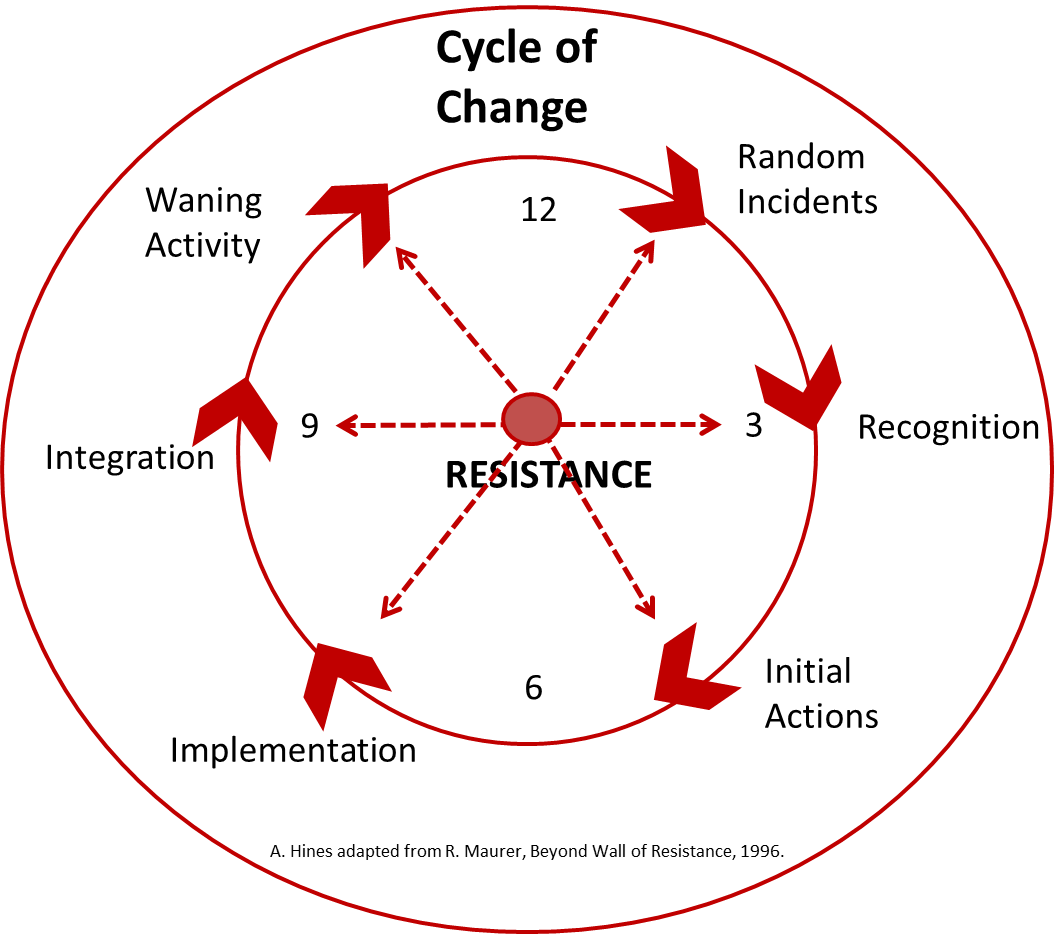I hope regular readers of this blog are comfortable with the notion that resistance to change is the norm, and that rather than fight it, we should embrace it [link to previous post]. I finally got to one of those books in my pile that focused on resistance: Rick Maurer, Beyond the Wall of Resistance: Unconventional Strategies That Build Support for Change, Austin, TX: Bard Books, 1996. And I’m glad I did!
While there are many things I liked about the book, my favorite is the “cycle of change,” which I slightly modified from the author who in turn adapted it from the Gestalt Institute of Cleveland. Think of the cycle of change as proceeding around a clock, slowed by resistance along the way. The guideposts along the way include:

- Random incidents (1:00): events related to the change are happening, but most in the organization are still unaware of need for change
- Recognition (3:00): the most critical stage – the shift occurs when everyone recognizes the situation
- Initial actions (5:00): the energy builds as the organization now wants to get busy and do something
- Implementation (7:00): the idea is rolled out
- Integration (9:00): the idea becomes part of the way the organization operates
- Waning activity (11:00): even the best ideas and plans eventually run their course
As you might imagine it is rarely a smooth journey across each guidepost. The depth of resistance and the change agent’s ability to deal with it influence the pace of the journey. And, of course, sometimes clocks stops, i.e., change initiative fails.
Here are some of the typical signs of resistance: [D and F are a couple that I’ve learned about the hard way.]
- Confusion
- Immediate criticism
- Denial
- Malicious compliance (people smile and appear to go along with the decision)
- Sabotage (easiest to spot)
- Easy agreement (quick acceptance turns to resistance when they realize what the changes mean)
- Deflection: unconscious….changing the subject
- Silence: difficult, because it gives you little to work with
- In-your-face criticism: belligerent and few others respect them, but avoid temptation to attack back
A key message of the book is that most of our typical reactions to resistance don’t help and usually make it worse. Rather than share what not to do, let’s look at what to do, namely to embrace the resistance by:
- Taking it seriously
- Treating those who resisted with respect
- Designing structures that aid communication
- Taking the long view
- Seeking mutual gain
Solid advice – my own experience is that I’ve moved in this direction, but I must admit that this piece ha taken very long for me to really get (and I’m not convinced I’ve really got it yet J): our own resistance to taking the time to engage resistance is a major reason for failure. We believe that getting others involved will slow us down too much. Indeed that can happen. But by moving more cautiously we have an opportunity to build commitment from the people who must approve or implement our dream. Yep, I have been fighting my impulses to just “get on with it!”
There’s more, but let’s jump to the punch line with the “formula:”
dissatisfaction x vision x first steps
x sensitivity to potential resistance
———————————————– = successful change
resistance
So, the organization needs to feel that something is wrong/not working; there is a vision of what can be done to address it; there are clearly identified first steps toward that vision; and resistance is embraced and dealt with. Hey, I can do that…..easier said than done. Andy Hines

Thank you Dr. Hines, very interesting. My guess is resistance will always be in various degrees depending on what the change is and exactly what it means to each individual. A small example would be IT adding new security measures and procedures to various business programs. The new security may slow down some programs used by some personnel. Those personnel may resist the change because it slows them down and/or frustrates them. Those who don’t use those programs will probably not have any resistance to the change. It is certainly a difficult task to deal with the various resistance levels within an organization, society, etc. and to find measures needed to be taken to engage and gain acceptance of change and still be successful, isn’t it?
your post reminds of a point in the book that resistance has a message for us if we are willing to hear it.